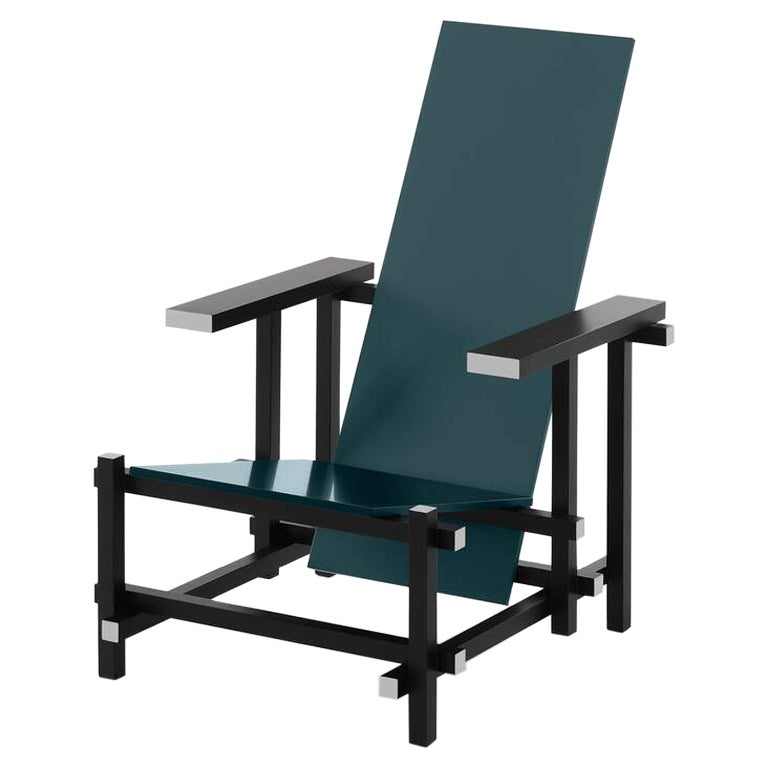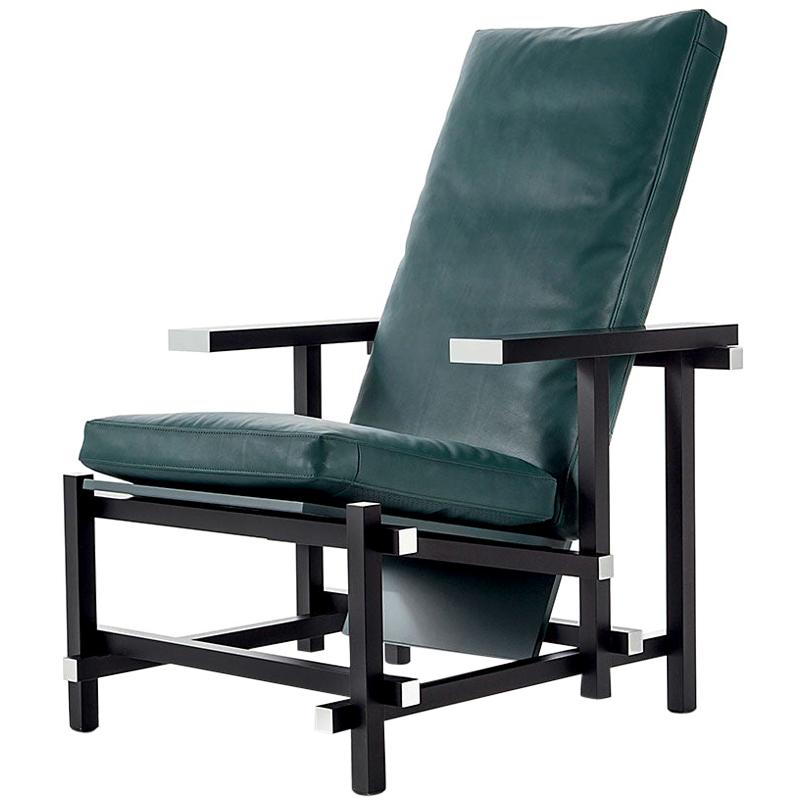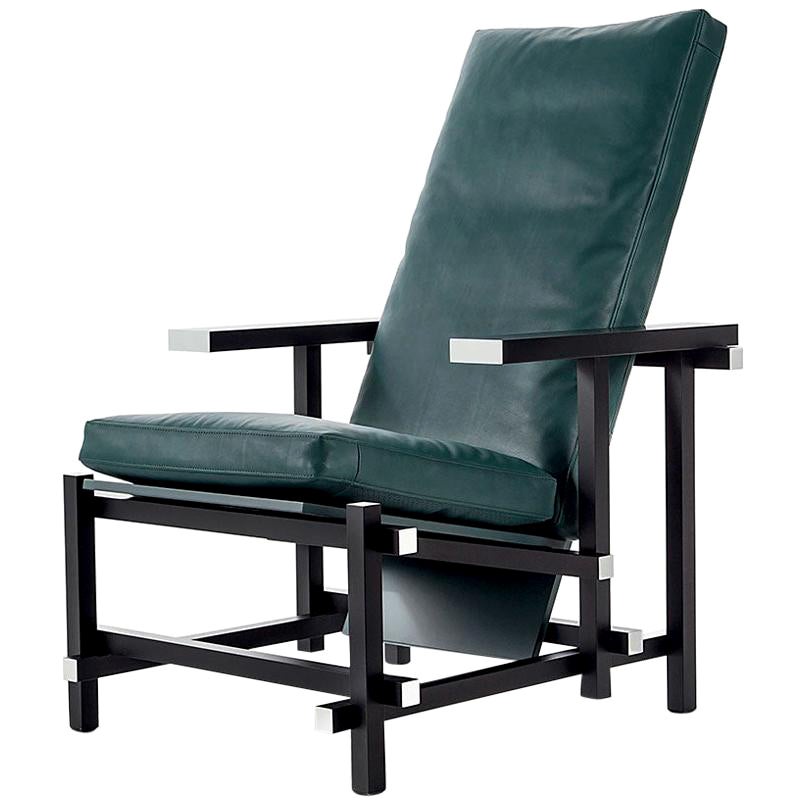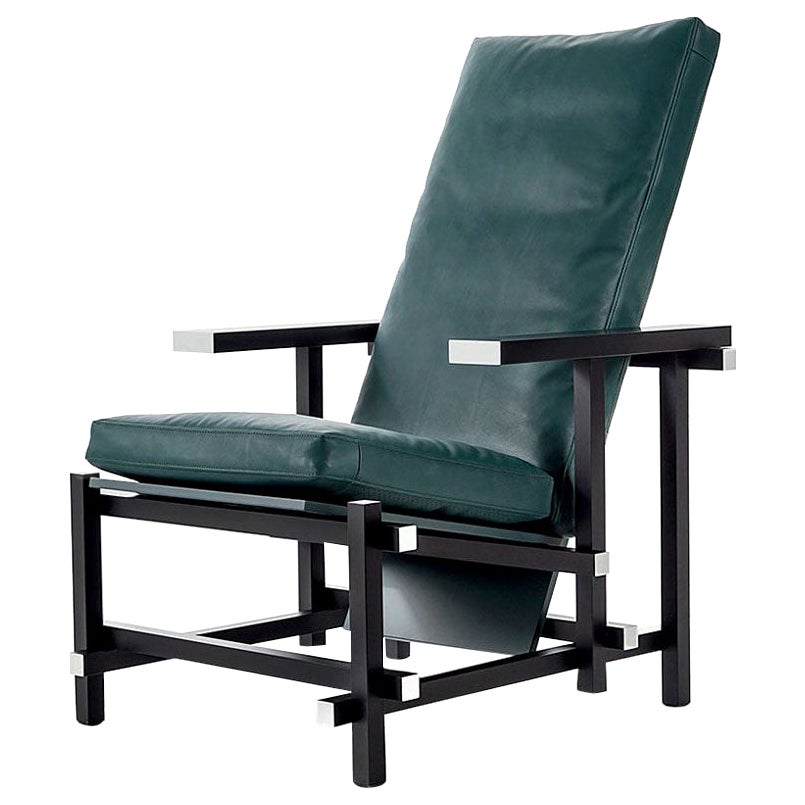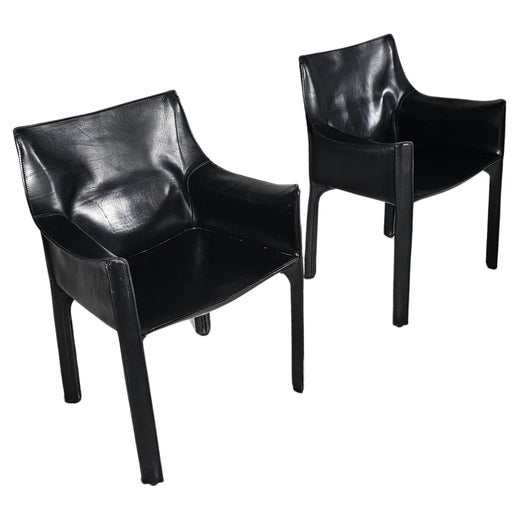Pair of Gerrit Rietveld 'Red and Blue Chair'
About the Item
- Creator:Cassina (Manufacturer),Gerrit Rietveld (Designer)
- Dimensions:Height: 34.65 in (88 cm)Width: 25.79 in (65.5 cm)Depth: 32.68 in (83 cm)Seat Height: 13 in (33 cm)
- Style:Modern (Of the Period)
- Materials and Techniques:
- Place of Origin:
- Period:
- Date of Manufacture:1980s
- Condition:Wear consistent with age and use. Very good condition. Structurally solid and sturdy. Only one small mark to the lacquer on one of the seat, and a slight lifting of the lacquer on the same seat (all as pictured). Otherwise in near perfect.
- Seller Location:London, GB
- Reference Number:1stDibs: LU6321231215502
Gerrit Rietveld
Best known for his Red and Blue chair, a modernist icon created using only two plywood plates and 15 connecting bars, Dutch designer Gerrit Thomas Rietveld trained as a cabinetmaker, and his bold vision for furniture was supported by his expertise in construction and craftsmanship.
Born in Utrecht, Rietveld learned goldsmithing in addition to the cabinetry apprenticeship he had in his carpenter father’s workshop. He studied draftsmanship with architect Piet Klaarhamer at the Utrecht Museum of Applied Arts and opened his own furniture workshop in 1917. In the 1930s, Rietveld began to experiment with then-unusual materials like plywood and aluminum, and he pursued intellectual concepts through his design, even considering a seat as a resting place for the body and the soul.
Designed in 1918, the minimalist Red and Blue chair is widely coveted by collectors and gained admirers in the likes of legendary American sculptor and designer Donald Judd over the years. (Examples of Rietveld’s designs can be found in Judd’s restored home-museum in New York City.) The Red and Blue chair is so stunning in its geometric simplicity that it is one of the most important symbols of the Dutch art and design movement of the early 20th century called De Stijl, of which Rietveld was an important part. De Stijl means “the Style” and was an effort to express utopian values through pure abstraction in design and the use of primary colors.
Another example of Rietveld’s celebrated seating furniture is the Zig-Zag chair, which was commissioned by the Dutch department store Metz & Co. and intended to be mass-produced. The resulting design — to which the rights to manufacture were bought by Cassina in 1971 — is the essence of the De Stijl movement and an example of Rietveld’s experiments with jointless chairs made from a single material, wood. The Zig-Zag chair’s armless, legless, elegant form is pure abstraction, yet it is also sturdy and comfortable.
Later in his career, Rietveld worked more often as an architect, designing buildings in prestigious settings like the Venice Biennale. He was a pioneer in more ways than one: The first building he designed, Rietveld Schröder House in Utrecht in 1924, is a radically modern space and has been a UNESCO World Heritage Site since 2000.
Find vintage Gerrit Rietveld furniture on 1stDibs.
Cassina
Furniture manufacturer Cassina is a prolific design house for more reasons than one: It not only owns the licenses to an exquisite collection of iconic chairs, sofas, tables and other pieces from the 20th and 21st centuries but also produces original works that are characterized by innovation and the finest Italian craftsmanship.
Cassina’s illustrious legacy includes being one of the first companies to bring industrial design to Italy in the 1950s. Founded in 1927 in Meda, Italy, by brothers Cesare and Umberto Cassina, the Italian manufacturing giant originally specialized in bespoke woodworking. In nearly a century since its founding, the company has shown incredible foresight about design trends and the evolution of technology.
In 1964, Cassina signed an exclusive licensing agreement to manufacture furniture by Le Corbusier and his collaborators — such as the LC4 chaise longue made with trailblazing French modernist Charlotte Perriand and Pierre Jeanneret — a move that would shape the future of the company. Cassina’s I Maestri collection is an ongoing initiative to restyle landmark designs from the 20th century, such as pieces by Gerrit Rietveld (the Red and Blue armchair from 1918), Charles Rennie Mackintosh, Erik Gunnar Asplund, Franco Albini and Frank Lloyd Wright. The company preserves the intentions and original styles of their designs but adds updated techniques, materials and processes — rendering them the best possible combination of past, present and future. The brand has also worked with contemporary icons like Zaha Hadid, Gio Ponti and Philippe Starck.
Cassina’s original designs are cutting-edge as well. They include pieces for everyday use, the development of which is guided by comfort and the marriage of Italian craftsmanship with industrial technology.
Some of Cassina’s pieces, both from its contemporary and I Maestri collections, can be found in the collections of museums like the Museum of Modern Art and the Vitra Design Museum. In 2014, the company became part of Haworth in its acquisition of Italian furniture group Poltrona Frau, and in 2015, Spanish designer Patricia Urquiola joined Cassina as its art director, leading the brand into its next century of inventive style.
Find a collection of new and vintage Cassina furniture on 1stDibs.
- ShippingRetrieving quote...Ships From: London, United Kingdom
- Return PolicyA return for this item may be initiated within 7 days of delivery.
- Pair Of Vintage Marcel Breuer Cesca Carver Chairs In Black, 1970sBy Marcel BreuerLocated in London, GBPair of vintage square back Marcel Breuer Cesca carver chairs with characterful patina to the frames. Perfect to complete a dining set or use as desk or lounge chairs.Category
Vintage 1970s Italian Mid-Century Modern Armchairs
MaterialsRattan, Beech
- Alessandro Albrizzi Director's Chair in Chrome And SuedeBy Alessandro AlbrizziLocated in London, GBDirector style armchair in chrome and brown suede. Alessandro Albrizzi (1934-1994). Italy, 1965. Completely original condition.Category
Vintage 1960s Italian Mid-Century Modern Armchairs
MaterialsSteel, Chrome
- Pair of Danish Armchairs by Rud Thygesen & Johnny Sørensen for Magnus OlesenBy Magnus OlesenLocated in London, GBA pair of beech framed upholstered armchairs designed by Rud Thygesen & Johnny Sørensen for Magnus Olesen Set of two armchairs from Thygesen and Sørensen‘s furniture collection. D...Category
Vintage 1970s Danish Scandinavian Modern Armchairs
MaterialsWool, Beech
- Spanish Wrought Iron and Leather Armchairs After Jacques AdnetBy Jacques AdnetLocated in London, GBA pair of Spanish wrought iron and leather armchairs. With handstitched rawhide seats and scroll details to the wrought iron backs. The semi-circular motif of the leg brace is...Category
Mid-20th Century Spanish Spanish Colonial Armchairs
MaterialsWrought Iron
- Vintage Mid Century Audoux Minet French Wicker and Pine ArmchairBy Adrien Audoux and Frida MinnetLocated in London, GBA rare hand crafted Audoux Minet armchair in pine and wicker. A vintage French classic, the chair was designed by Adrien Audoux and Frida Minet in the mid century. Extremely comforta...Category
Mid-20th Century French French Provincial Armchairs
MaterialsHemp, Cord, Pine
- Vintage Ernest Race Heron Armchair and Footstool in White Bouclé, Britain, 1950sBy Ernest Race, Race FurnitureLocated in London, GBA completely reupholstered Heron chair by Ernest Race from the 1950s, along with original footstool. An impressive and ergonomic design, the Heron armchair...Category
Vintage 1950s British Mid-Century Modern Lounge Chairs
MaterialsSteel
- Gerrit Rietveld Red and Blue Chair by CassinaBy Cassina, Gerrit RietveldLocated in Barcelona, BarcelonaChair designed by Gerrit Rietveld in 1918. Relaunched in 1973. Manufactured by Cassina in Italy. A sculptural seat with a pure and rationalist form, this chair became an authenti...Category
2010s Italian Mid-Century Modern Armchairs
MaterialsWood
- Gerrit Rietveld Red and Blue Chair for Cassina, Italy, newBy Gerrit Rietveld, CassinaLocated in Berlin, DEChair designed by Gerrit Rietveld in 1918. Relaunched in 1973. Manufactured by Cassina in Italy.Category
21st Century and Contemporary Italian Chairs
MaterialsWood
- Gerrit Rietveld Zeilmaker Version of Black Red and Blue Chair by CassinaBy Gerrit Rietveld, CassinaLocated in Barcelona, BarcelonaChair designed by Gerrit Rietveld in 1920. Relaunched in 2015. Manufactured by Cassina in Italy. One of the versions of the iconic model dated 1918. The structure is in black-stained beechwood with white contrasting parts. Seat and back in green lacquered multiplywood. The black red and blue (Zeilmaker version) born from Rietveld’s chromatic experimentation While researching the origins of the red and blue model in collaboration with the Rietveld heirs, it emerged that the key idea of the first prototypes was based on the concept of spatial organization expressed through the monochrome tones of its elements. The first version was in fact produced in 1918 in completely unpainted wood. In the following years Rietveld proposed various examples, either monochrome or painted in different colors, depending on the requirements of his customers and the interiors for which the chairs were intended. As such, it comes as no surprise to find this 1920s version, presented as part of Cassina’s MutAzioni selection, created for the school teacher Wicher Zeilmaker with a black frame with white ends and a dark green painted seat and backrest. It was Rietveld’s ever-increasing involvement in the De Stijl movement that led him to also use primary colors on this model in 1923, and as such the chair became a veritable manifesto for the emerging neoplastic movement. Initially dubbed slat chair, Rietveld only gave it the name red and blue in the 1950s following its chromatic evolution. The various owners of the different examples used the chair as an abstract-realist sculpture in their interiors and, in some cases, as a simple tool for sitting on, adding cushions to make it more comfortable, just like Cassina offers for the black red and blue today. Important information regarding images of products: Please note that some of the images show other colors and variations of the model, these images are only to present interior design proposals. The item that is selling is on the first image. Important information regarding color(s) of products: Actual colors may vary. This is due to the fact that every computer monitor, laptop, tablet and phone screen has a different capability to display colors and that everyone sees these colors differently. We try to edit our photos to show all of our products as life-like as possible, but please understand the actual color may vary slightly from your monitor About the designer: Gerrit Thomas Rietveld, born in Utrecht on 24 June 1888, seems possessed of two personalities, each so distinct that one might take his work to be that of more than one artist. The first personality is that seen in the craftsman cabinet-maker working in a primordial idiom, re-inventing chairs and other furniture as if no one had ever built them before him and following a structural code all of his own; the second is that of the architect working with elegant formulas, determined to drive home the rationalist and neoplastic message in the context of European architecture. The two activities alternate, overlap, and fuse in a perfect osmosis unfolding then into a logical sequence. In 1918 Rietveld joined the “De Stijl” movement which had sprung up around the review of that name founded the year before by Theo van Doesburg. The group assimilated and translated into ideology certain laws on the dynamic breakdown of compositions (carrying them to an extreme) that had already been expressed in painting by the cubists: the “De Stijl” artists also carefully studied the architectonic lesson taught by the great Frank Lloyd Wright, whose influence was widely felt in Europe at that time. Collaborating first with Robert van’t Hoff and Vilmos Huszar, then with Theo van Doesburg and Cornelius van Eesteren, Rietveld soon became one of the most distinguished interpreters of the neoplastic message. Among his most important works are: the Schröder house at Utrecht (1924); the “Row Houses” at Utrecht (1931-1934); the Dutch pavilion at the Venice Biennial (1954); the sculpture pavilion in the Rijksmuseum Kröller-Müller at Otterloo and the Van Gogh Museum in Amsterdam (1955). Out of his equally important furniture, Cassina has chosen for its own production: the “Red and Blue” (1918), the “Zig-Zag” (1934), the “Schröder 1...Category
2010s Italian Mid-Century Modern Armchairs
MaterialsLeather, Wood
- Gerrit Rietveld Zeilmaker Version of Black Red and Blue Chair by CassinaBy Gerrit Rietveld, CassinaLocated in Barcelona, BarcelonaChair designed by Gerrit Rietveld in 1920. Relaunched in 2015. Manufactured by Cassina in Italy. One of the versions of the iconic model dated 1918. The structure is in black-stained beechwood with white contrasting parts. Seat and back in green lacquered multiplywood. The armchair can have a single seat and backrest cushion in fabric or leather. The black red and blue (Zeilmaker version) born from Rietveld’s chromatic experimentation While researching the origins of the red and blue model in collaboration with the Rietveld heirs, it emerged that the key idea of the first prototypes was based on the concept of spatial organization expressed through the monochrome tones of its elements. The first version was in fact produced in 1918 in completely unpainted wood. In the following years Rietveld proposed various examples, either monochrome or painted in different colors, depending on the requirements of his customers and the interiors for which the chairs were intended. As such, it comes as no surprise to find this 1920s version, presented as part of Cassina’s MutAzioni selection, created for the school teacher Wicher Zeilmaker with a black frame with white ends and a dark green painted seat and backrest. It was Rietveld’s ever-increasing involvement in the De Stijl movement that led him to also use primary colors on this model in 1923, and as such the chair became a veritable manifesto for the emerging neoplastic movement. Initially dubbed slat chair, Rietveld only gave it the name red and blue in the 1950s following its chromatic evolution. The various owners of the different examples used the chair as an abstract-realist sculpture in their interiors and, in some cases, as a simple tool for sitting on, adding cushions to make it more comfortable, just like Cassina offers for the black red and blue today. Production delay: 8-9 weeks Important information regarding images of products: Please note that some of the images show other colors and variations of the model, these images are only to present interior design proposals. The item that is selling is on the first image. Important information regarding color(s) of products: Actual colors may vary. This is due to the fact that every computer monitor, laptop, tablet and phone screen has a different capability to display colors and that everyone sees these colors differently. We try to edit our photos to show all of our products as life-like as possible, but please understand the actual color may vary slightly from your monitor About the designer: Gerrit Thomas Rietveld, born in Utrecht on 24 June 1888, seems possessed of two personalities, each so distinct that one might take his work to be that of more than one artist. The first personality is that seen in the craftsman cabinet-maker working in a primordial idiom, re-inventing chairs and other furniture as if no one had ever built them before him and following a structural code all of his own; the second is that of the architect working with elegant formulas, determined to drive home the rationalist and neoplastic message in the context of European architecture. The two activities alternate, overlap, and fuse in a perfect osmosis unfolding then into a logical sequence. In 1918 Rietveld joined the “De Stijl” movement which had sprung up around the review of that name founded the year before by Theo van Doesburg. The group assimilated and translated into ideology certain laws on the dynamic breakdown of compositions (carrying them to an extreme) that had already been expressed in painting by the cubists: the “De Stijl” artists also carefully studied the architectonic lesson taught by the great Frank Lloyd Wright, whose influence was widely felt in Europe at that time. Collaborating first with Robert van’t Hoff and Vilmos Huszar, then with Theo van Doesburg and Cornelius van Eesteren, Rietveld soon became one of the most distinguished interpreters of the neoplastic message. Among his most important works are: the Schröder house at Utrecht (1924); the “Row Houses” at Utrecht (1931-1934); the Dutch pavilion at the Venice Biennial (1954); the sculpture pavilion in the Rijksmuseum Kröller-Müller at Otterloo and the Van Gogh Museum in Amsterdam (1955). Out of his equally important furniture, Cassina has chosen for its own production: the “Red and Blue” (1918), the “Zig-Zag” (1934), the “Schröder 1...Category
2010s Italian Mid-Century Modern Armchairs
MaterialsWood, Leather
- Gerrit Rietveld Zeilmaker Version of Black Red and Blue Chair by CassinaBy Gerrit Rietveld, CassinaLocated in Barcelona, BarcelonaChair designed by Gerrit Rietveld in 1920. Relaunched in 2015. Manufactured by Cassina in Italy. One of the versions of the iconic model dated 1918. The structure is in black-stained beechwood with white contrasting parts. Seat and back in green lacquered multiplywood. The armchair can have a single seat and backrest cushion in fabric or leather. The black red and blue (Zeilmaker version) born from Rietveld’s chromatic experimentation While researching the origins of the red and blue model in collaboration with the Rietveld heirs, it emerged that the key idea of the first prototypes was based on the concept of spatial organization expressed through the monochrome tones of its elements. The first version was in fact produced in 1918 in completely unpainted wood. In the following years Rietveld proposed various examples, either monochrome or painted in different colors, depending on the requirements of his customers and the interiors for which the chairs were intended. As such, it comes as no surprise to find this 1920s version, presented as part of Cassina’s MutAzioni selection, created for the school teacher Wicher Zeilmaker with a black frame with white ends and a dark green painted seat and backrest. It was Rietveld’s ever-increasing involvement in the De Stijl movement that led him to also use primary colors on this model in 1923, and as such the chair became a veritable manifesto for the emerging neoplastic movement. Initially dubbed slat chair, Rietveld only gave it the name red and blue in the 1950s following its chromatic evolution. The various owners of the different examples used the chair as an abstract-realist sculpture in their interiors and, in some cases, as a simple tool for sitting on, adding cushions to make it more comfortable, just like Cassina offers for the black red and blue today. Important information regarding images of products: Please note that some of the images show other colors and variations of the model, these images are only to present interior design proposals. The item that is selling is on the first image. Important information regarding color(s) of products: Actual colors may vary. This is due to the fact that every computer monitor, laptop, tablet and phone screen has a different capability to display colors and that everyone sees these colors differently. We try to edit our photos to show all of our products as life-like as possible, but please understand the actual color may vary slightly from your monitor About the designer: Gerrit Thomas Rietveld, born in Utrecht on 24 June 1888, seems possessed of two personalities, each so distinct that one might take his work to be that of more than one artist. The first personality is that seen in the craftsman cabinet-maker working in a primordial idiom, re-inventing chairs and other furniture as if no one had ever built them before him and following a structural code all of his own; the second is that of the architect working with elegant formulas, determined to drive home the rationalist and neoplastic message in the context of European architecture. The two activities alternate, overlap, and fuse in a perfect osmosis unfolding then into a logical sequence. In 1918 Rietveld joined the “De Stijl” movement which had sprung up around the review of that name founded the year before by Theo van Doesburg. The group assimilated and translated into ideology certain laws on the dynamic breakdown of compositions (carrying them to an extreme) that had already been expressed in painting by the cubists: the “De Stijl” artists also carefully studied the architectonic lesson taught by the great Frank Lloyd Wright, whose influence was widely felt in Europe at that time. Collaborating first with Robert van’t Hoff and Vilmos Huszar...Category
2010s Italian Mid-Century Modern Armchairs
MaterialsLeather, Wood
- Gerrit Rietveld Zeilmaker Version of Black Red and Blue Chair by CassinaBy Gerrit Rietveld, CassinaLocated in Barcelona, BarcelonaChair designed by Gerrit Rietveld in 1920. Relaunched in 2015. Manufactured by Cassina in Italy. One of the versions of the iconic model dated 1918. The structure is in black-stained beechwood with white contrasting parts. Seat and back in green lacquered multiplywood. The armchair can have a single seat and backrest cushion in fabric or leather. The black red and blue (Zeilmaker version) born from Rietveld’s chromatic experimentation While researching the origins of the red and blue model in collaboration with the Rietveld heirs, it emerged that the key IDEA of the first prototypes was based on the concept of spatial organization expressed through the monochrome tones of its elements. The first version was in fact produced in 1918 in completely unpainted wood. In the following years Rietveld proposed various examples, either monochrome or painted in different colors, depending on the requirements of his customers and the interiors for which the chairs were intended. As such, it comes as no surprise to find this 1920s version, presented as part of Cassina’s MutAzioni selection, created for the school teacher Wicher Zeilmaker with a black frame with white ends and a dark green painted seat and backrest. It was Rietveld’s ever-increasing involvement in the De Stijl movement that led him to also use primary colors on this model in 1923, and as such the chair became a veritable manifesto for the emerging neoplastic movement. Initially dubbed slat chair, Rietveld only gave it the name red and blue in the 1950s following its chromatic evolution. The various owners of the different examples used the chair as an abstract-realist sculpture in their interiors and, in some cases, as a simple tool for sitting on, adding cushions to make it more comfortable, just like Cassina offers for the black red and blue today. Important information regarding images of products: Please note that some of the images show other colors and variations of the model, these images are only to present interior design proposals. The item that is selling is on the first image. Important information regarding color(s) of products: Actual colors may vary. This is due to the fact that every computer monitor, laptop, tablet and phone screen has a different capability to display colors and that everyone sees these colors differently. We try to edit our photos to show all of our products as life-like as possible, but please understand the actual color may vary slightly from your monitor About the designer: Gerrit Thomas Rietveld, born in Utrecht on 24 June 1888, seems possessed of two personalities, each so distinct that one might take his work to be that of more than one artist. The first personality is that seen in the craftsman cabinet-maker working in a primordial idiom, re-inventing chairs and other furniture as if no one had ever built them before him and following a structural code all of his own; the second is that of the architect working with elegant formulas, determined to drive home the rationalist and neoplastic message in the context of European architecture. The two activities alternate, overlap, and fuse in a perfect osmosis unfolding then into a logical sequence. In 1918 Rietveld joined the “De Stijl” movement which had sprung up around the review of that name founded the year before by Theo van Doesburg. The group assimilated and translated into ideology certain laws on the dynamic breakdown of compositions (carrying them to an extreme) that had already been expressed in painting by the cubists: the “De Stijl” artists also carefully studied the architectonic lesson taught by the great Frank Lloyd Wright, whose influence was widely felt in Europe at that time. Collaborating first with Robert van’t Hoff and Vilmos Huszar, then with Theo van Doesburg and Cornelius van Eesteren, Rietveld soon became one of the most distinguished interpreters of the neoplastic message. Among his most important works are: the Schröder house at Utrecht (1924); the “Row Houses” at Utrecht (1931-1934); the Dutch pavilion at the Venice Biennial (1954); the sculpture pavilion in the Rijksmuseum Kröller-Müller at Otterloo and the Van Gogh Museum in Amsterdam (1955). Out of his equally important furniture, Cassina has chosen for its own production: the “Red and Blue” (1918), the “Zig-Zag” (1934), the “Schröder 1...Category
2010s Italian Mid-Century Modern Armchairs
MaterialsLeather, Wood
Recently Viewed
View AllRead More
The 21 Most Popular Mid-Century Modern Chairs
You know the designs, now get the stories about how they came to be.
Billy Cotton Layers His Interiors with Lived-In Comfort
The Brooklyn-based designer is adept at styles ranging from austere to over-the-top, espousing an architectural, detail-oriented approach also evident in his line of furniture and lighting.


